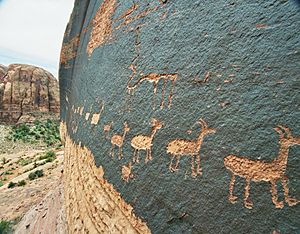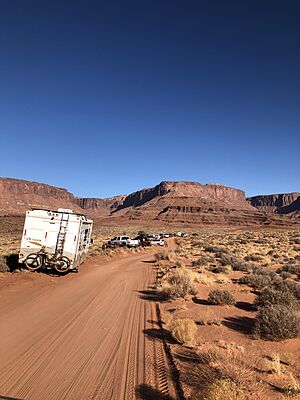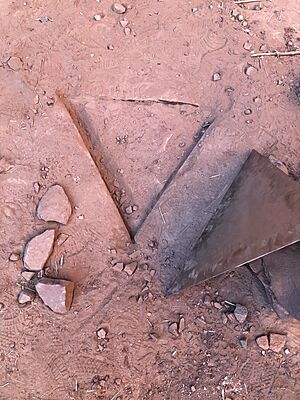Utah monolith facts for kids
Quick facts for kids Utah monolith |
|
|---|---|

The monolith at its original location
|
|
| Artist | Unknown |
| Year | 2016 |
| Type | Metal sculpture |
| Medium | stainless steel or aluminum (assumed) |
| Dimensions | 291 cm × 50.6 cm × 58 cm (114.5 in × 19.92 in × 23.0 in) |
| Condition | disassembled but later reassembled |
| Location | formerly Lockhart Basin in San Juan County, Utah, United States; 27 km (17 mi) southwest of Moab, currently held at undisclosed location by the Bureau of Land Management |
| 38°20′35.1″N 109°39′58.3″W / 38.343083°N 109.666194°W | |
The Utah monolith was a mysterious metal pillar found in a red rock canyon in Utah, United States. This tall, three-sided metal structure was secretly placed on public land sometime between July and October 2016. It stood hidden for over four years.
No one knew it was there until its discovery and removal in late 2020. We still don't know who made it or why they put it there.
Utah state wildlife experts found the monolith in November 2020. They were flying in a helicopter to count wild bighorn sheep. Soon after, people used GPS maps to find the hidden spot. News about the monolith spread quickly.
On November 27, 2020, four people from Moab, Utah secretly took the monolith away. After holding it for almost a month, they gave it to the Bureau of Land Management. It is now safely stored by them.
After the Utah monolith was found, over 200 similar metal pillars appeared worldwide. These were built in places like North America, Europe, and South America. Many were made by local artists who were inspired by the Utah monolith.
Contents
Discovering the Utah Monolith
On November 18, 2020, wildlife officials were flying over southeastern Utah. They were counting bighorn sheep from a helicopter. The helicopter was flown by the Utah Department of Public Safety (DPS).
While flying over a narrow canyon, one official saw the shiny pillar. He told the pilot, Bret Hutchings, to fly back. Hutchings later said:
One of the biologists is the one who spotted it and we just happened to fly directly over the top of it. He was like, "Whoa, whoa, whoa, turn around, turn around!" And I was like, "What?" And he's like, "There's this thing back there – we've got to go look at it!"
Hutchings thought the object looked manmade. It seemed to be placed firmly in the ground, not dropped from above. He joked, "We were kind of joking around that if one of us suddenly disappears, then the rest of us make a run for it."
On November 20, the Utah DPS shared a photo of the pillar on Instagram. On November 23, they released videos and photos on their website. They called it "DPS Aero Bureau Encounters Monolith in Red Rock Country." They did not share its exact location to keep people safe.
Where Was the Monolith Found?

The monolith was placed by unknown people in a red sandstone canyon. This area is in Lockhart Basin, northern San Juan County. It was on public land.
This land was part of the Bears Ears National Monument until 2017. It was added back to the monument in 2021. The area where the monolith stood had no public services. There were no parking spots, restrooms, or cell phone service.
The DPS did not share the exact location. They wanted to stop people from getting lost or hurt trying to find it. But within hours, a Reddit user named Tim Slane found the object on Google Earth.
Slane compared the helicopter's flight path with the red rock views from the videos. He used clues like cliff heights and canyon shapes. Google Earth satellite pictures showed the monolith was put there between August 2015 and October 2016. The pictures also showed that plants around it had been cleared.
A Dutch journalist, Nouska du Saar, used Maxar satellite images. She confirmed the monolith appeared between July 7, 2016, and October 21, 2016.
Within two days of the DPS announcement, people reached the site. They posted photos and videos online. Local people worried that too many visitors might harm nearby Native American sites and old artifacts.
What Did the Monolith Look Like?
The metal structure stood about 3 meters (10 feet) tall. Each of its three sides was about 58 centimeters (23 inches) wide. It was a triangular prism, meaning it had three flat sides.
The monolith was not magnetic. It seemed to be made of thin stainless steel or aluminum sheets. These sheets were joined with rivets, making the inside hollow. There was silicone caulk or epoxy at its base. When hit, the metal made a quiet sound, suggesting something inside. It was put together using blind rivets. This showed it was manmade, but it made it hard to guess its age.
Dave Sparks from the TV show Diesel Brothers visited the monolith. He said in a video, "They got a concrete saw and they cut it into the red rock there." He pointed out cuts at the bottom. Wendy Wischer, an art expert, said, "One person alone could not have done it. So there is a group of people who have some knowledge of it somewhere."

When the DPS first found the pillar, they called it a "monolith." This word usually means a single large stone. However, it is also linked to the famous "Monolith" from the movie 2001: A Space Odyssey. The Utah monolith looked a bit like the one in the movie.
Why Was the Monolith Illegal?

The DPS said that it is against the rules to put structures on public land without permission. This rule applies to all art, "no matter what planet you're from."
The Utah Department of Heritage & Arts said the monolith was an act of vandalism. They were worried about damage to ancient artwork and historical items in the area.
The #UtahMonolith has prompted discussions about public art and inspired people to visit the site, despite efforts to keep it secret. Our department includes @UT_Indian @UTHistory @UtahArtsMuseums, and we want to raise a couple of important points. [...]
First, debates about #UtahMonolith as artistic statement shouldn’t equate it with rock art. This piece is a contemporary statement. Ancient petroglyphs, pictographs, and rock art are protected archaeological treasures with established cultural and historical significance.
While curiosity is understandable, we discourage visiting the monolith. Along with safety concerns, increased crowds threaten the archaeological resources in the area. Unintentional damage is still damage.
If you still choose to visit, please do not damage any rock art and don’t gather archaeological items such as arrowheads. Leave the area as undisturbed as possible.
Finally, while the monolith has better craftsmanship than graffiti, this is still vandalism. It irreversibly altered the natural environment on public lands. While the monolith is interesting, we cannot condone vandalism of any type.
How Was the Monolith Removed?
The Utah BLM said the monolith was removed on the evening of November 27, 2020. At first, no one knew who did it. Later, it was revealed to be four people from Moab, Utah: Andy Lewis, Sylvan Christensen, Homer Manson, and another friend.
Some adventure photographers shared details and pictures of the monolith being taken apart. One person saw the four men push the monolith over without tools. Onlookers watched. The men said, "this is why you don't leave trash in the desert." Then they broke it apart and carried the pieces away in a wheelbarrow. The group followed the idea of "Leave No Trace" to protect nature.
Photos of the site afterward showed only a triangular metal piece left. Witnesses saw a pickup truck driving away with an object as they arrived.
The BLM in Utah said on Facebook on November 28, 2020, that they did not remove the monolith. They said it was private property, so they would not investigate. They left it to the local sheriff's office. The San Juan County Sheriff's Office said they did not have enough staff to investigate. However, they did post a "Most Wanted" poster on their Facebook page.
On November 30, 2020, officials changed their minds. They planned a joint investigation with the Bureau of Land Management.
Four days after the monolith was removed, Lewis and Christensen posted a video online. It was called "We Removed the Utah monolith." It showed them and two others taking the monolith away in a wheelbarrow. Christensen also posted the video on TikTok and Instagram. He talked about rules for using public lands and protecting nature. He also pointed out the damage caused by many visitors to an area with no parking or restrooms. Christensen later said he received angry messages and threats because of his video.
On December 20, 2020, Lewis released a video on Instagram. It showed what looked like the Utah monolith still in his backyard. This was different from what some people thought, that it had been destroyed. He said he and his friends heard plans to destroy the monolith on the night it was removed. So, they took it to save it. He also said they gave it to the Bureau of Land Management. They hoped the BLM would study its origin and find a new home for it.
Other Similar Monoliths
Soon after the Utah monolith was found, over 200 similar metal pillars appeared around the world. In some cases, local artists said they made them. They said the Utah monolith inspired them. Other monoliths were made by small businesses for advertising.
See also
- Minimalism (visual arts)
- Seattle Monolith
- Site-specific art
- Trail ethics



